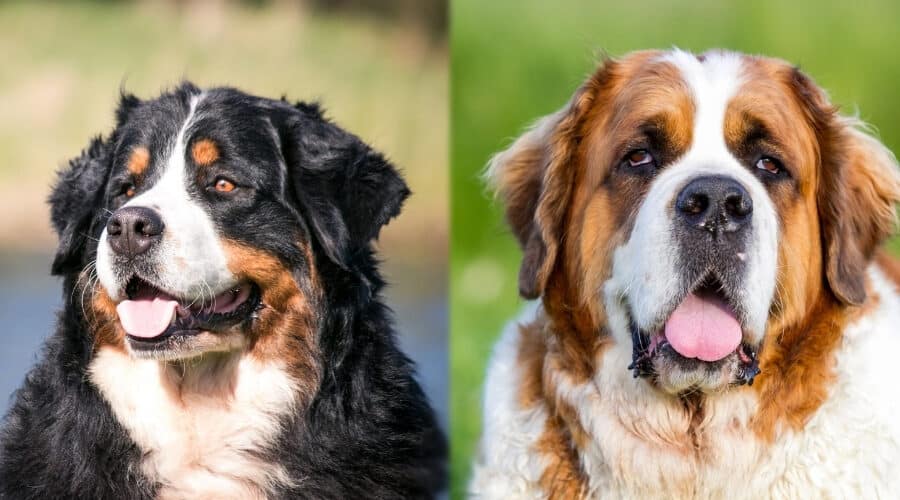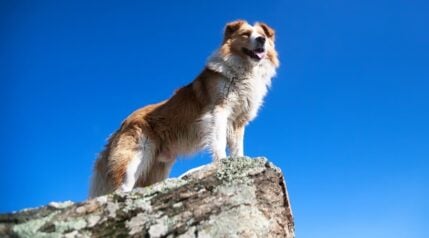Are you comparing the Bernese Mountain Dog vs. the Saint Bernard for your next fluffy-haired companion? While these dog breeds do look similar, they actually have some very different traits and personalities.
If you think they look like they are siblings, you’d be right. They actually are related in some way. But what are there any differences between them? Thankfully, there are a few distinctions that might help you to choose between them.
Both dog breeds are fairly large, so regardless of which one you might feel is a better fit based on personality, you’ll need to be prepared to welcome a lot of dog into your home. They both also slobber, so if you can handle both their size and drool, you just might find a perfect family companion.
Here in this guide, we will pit them against each other, in a friendly way, of course. And run through their similarities and differences. All in a bid to help you discover which breed is better for your family and lifestyle. So, let’s jump in and talk all things Swiss pups.
Breed Comparison
Bernese Mountain Dog
- Height 23-28 Inches
- Weight 70-115 Pounds
- Temperament Good Natured, Calm, Strong
- Energy Medium
- Health Average
- Lifespan 7-10 Years
- Price $1,000 and Up
Saint Bernard
- Height 26-30 Inches
- Weight 120-180 Pounds
- Temperament Playful, Charming, Inquisitive
- Energy Medium
- Health Average
- Lifespan 8-10 Years
- Price $1,500 and Up
Key Differences
- Bernese Mountain Dogs are smaller, reaching 70 – 115 pounds.
- Saint Bernards are larger, reaching 120 to 180 pounds.
- The Bernese Mountain Dog has a longer, silky coat.
- The Saint Bernand has much droopier jowls.
- Bernese Mountain Dogs are more energetic.
- Saint Bernards have a slightly longer life expectancy, 8 to 10 years, vs. the Bernese’s 7 to 10 years.
- The Bernese Mountain Dog is easier to train.
- Saint Bernards are famous for their gentle nature with children.
- Bernese Mountain Dogs generally have a tri-color coat.
Breed History
First, let’s take a closer look at their histories and how they are linked to one another. Often, looking at a dog’s original breed purpose will help you discover what they will be like as family pets. So, it’s a great place to start.
Bernese Mountain Dog

The Bernese Mountain Dog is affectionately known as the Berner, which is what we will refer him to throughout this guide.
This guy hails from Bern in Switzerland, and he is a relatively new breed compared to the Saint Bernard. The area of Bern is known for its beautiful rolling pasture lands, and it’s still home to over 12,000 dairy farms. The Berner helped his farmer master drive cattle, protect the farm, and pull heavy carts full of cheese. When farmers began to favor tractors for transport, the Berner was out of favor, and his numbers dwindled.
A Swiss doctor and most renowned dog breeder in his day, Albert Heim, established a breed club in 1907 and sought to save the breeds, as well as other Swiss mountain dogs.
A pair of fine Berner specimens were imported to Kansas in 1926, and the rest was history. He is the most popular Swiss mountain dog, and celebrities such as Michelle Gellar and Courtney Cox have fallen in love with the breed.
Saint Bernard

The Saint Bernard, contrary to popular belief, is not one of the four mountain dogs. But they do share the same ancestors, which is why they look similar. Just like the Berner, his sheer size led him to farmwork. But he is best known for his incredible relationship with mankind. Established over the years in the Swiss Alps where he originates from.
Roman war dogs traveling through the Swiss Alps were his forefathers, and there he settled down to assist the monks of the Alps. A hospice was established to assist wayward travelers, and it was the Saint Bernard’s job to locate them and carry them back to safety.
He developed a sense of knowing when avalanches were coming. It is estimated that he has saved 2,000 lives during his three centuries at the hospice. Because of their size and handsome appearance, they are popular parent breeds for several designer dogs.
Appearance

As giant dog breeds sharing the traditional Swiss colors, they look very similar to one another. The smaller Berner weighs between 70 and 115 pounds, and he measures between 23 and 27 ½ inches tall. The Saint Bernard weighs much more, between 120 and 180 pounds, and he measures 26 to 30 inches tall. It is this size difference that often determines which dog breed they choose.
The Saint Bernard has droopier jowls, and his eyes are often described as sad looking. In part, this is because of his jowls that pull on the skin around his eyes. They are both handsome dogs with fleshy square noses, big paws, and muscular bodies. Although we’d say more ‘dad bod’ than ripped muscles.
The Berner is the only mountain dog to have a long and silky coat. The Saint Bernard has the choice of two coats, which are either short or a shaggier coat that is of medium length. They both sport the famous Swiss black, white, and rust colors, with the white forehead blaze from his muzzle to the top of his head. The Saint Bernard enjoys a host of other colors, which are much rarer. Such as brindle grizzle, brown and white, red and white, orange and white.
Temperament

These two breeds are even more similar in their temperament than their appearance. The first difference is that although they both make great family dogs, the Saint Bernard is known for his affinity for children. This is why he is referred to as the nanny dog and given the part of “Nanny” in the Peter Pan stories.
The Berner loves children too, but not as much as the Saint Bernard. So, if you have young children that you want help with entertaining them, the Saint Bernard might be the more obvious choice. However, they are both affectionate and full of love for their family. The Berner is equally loyal to his humans, and he is becoming a popular therapy dog for this reason.
Neither of them realizes their size, and they love to squeeze themselves on the sofa. They are both big goofballs and known to be quite clumsy too. So, if you have any favorite vases or ornaments, we’d suggest placing them out of tail’s reach. They are both great fun and love to get involved with family games in the yard.
The Berner is more energetic than the Saint Bernard, and he needs a more active family. Not only does he need a bit more exercise, but it also needs to be more intense. He also needs more interaction during the day and will sulk if he gets bored.
The Saint Bernard is notorious for having a slightly lower intelligence level than other breeds and also being potentially aggressive if not socialized early. While we wouldn’t say this is “normal,” it’s something to consider if you plan to welcome this breed into your home.
Exercise

The Saint Bernard only needs around 30 to 45 minutes of exercise a day. He isn’t interested in intense activities such as mountain hiking or jogging. He prefers leisurely strolls around the local park. The Berner needs around 60 minutes a day. This guy doesn’t like seriously intensive activities either. But he could keep up with a mountainous walk every once in a while.
It’s safe to say that if you are an active family looking for a pooch to join you on your mild adventures, the Berner is the better choice for you. Bear in mind that they are both giant dogs, and their activities shouldn’t be too impactive, as this can cause issues with their joints. So, if you are super active and looking for a jogging partner, neither of these breeds is ideal for you. Mild not wild, is the motto with these gentle giants.
Training

When it comes to training, both breeds are intelligent and eager to please their humans. They both respond well to training, which is why they have done so well with their human-oriented occupations in the past. And with a treat in hand, you can be sure that positive reinforcement training is the most efficient way to train them. Start obedience training young to ensure they are well-behaved.
As both giant dogs, they need to be socialized well from an early age. The most crucial part of their socialization period is between 8 to 16 weeks, and your breeder will begin the process. But you need to continue the training and meet up with other dogs and humans. Get it right, and they’ll turn into the lovable, gentle giants that everyone knows and loves.
Health

Both dog breeds are relatively healthy, but due to their giant size, they enjoy a shorter lifespan compared to other dogs. Their lifespan is 7 to 10 years and 8 to 10 years, respectively. They share the same health concerns, and they should be tested for the following health conditions if they are to be bred. Reputable breeders will be able to show you health clearances, so be sure to ask them.
The Berner and the Saint Bernard are both prone to elbow and hip dysplasia. They are also prone to various eye concerns including progressive retinal atrophy, ectropion, entropion, and cataracts. And finally, they are also both prone to heart conditions, in particular, dilated cardiomyopathy. In addition to this, the Bernese Mountain Dog should be screened for Von Willebrand’s disease.
Nutrition

The Berner will consume between three to four cups of food every day, and the Saint Bernard eats around six cups of food a day. This can make a big difference to the food bill, sometimes doubling it. And so finances are a big consideration here if you are to take the Saint Bernard on. What they consume is all dependent on their age, size, and energy levels.
They will both do well on a high-quality kibble. Not only will they provide a well-balanced diet, but they will be tasty enough for your big giants to enjoy. As giant dogs, they should be fed a kibble designed for large or giant breeds. This is crucial in their developmental stages, as they contain the optimum levels of calcium and phosphorus. This will help control their rapid bone growth, which will reduce the chances of them developing skeletal diseases such as joint dysplasia.
They are both prone to weight gain and obesity, so do not overfeed them. This will put extra pressure on their joints and lead to other health concerns. Kibbles that contain glucosamine and chondroitin will help to support their joints. Or glucosamine supplements or fish oils are just as good.
Grooming

The difference in their grooming schedule is all dependent on what type of coat the Saint Bernard sports. If he sports a short haircut, he will only need brushing once or twice a week throughout the year.
If you adopt one with a longer coat, which is similar to the Bernese Mountain Dog’s coat, they will need to be brushed two or three times a week. The Saint Bernard, in general, will shed about the same amount as a Berner.
They both have double coats, and they both shed similarly throughout the year. During the shedding seasons, they will both need brushing most days if you want to manage their shedding effectively. They are both droolers, so if you aren’t a fan of doggy drool, neither of these breeds is for you.
The breeds both need to be bathed once every 8 to 12 weeks. Similarly, they will benefit from a concentrated and conditioning shampoo, considering how fluffy and thick their coat is. As they both suffer from various eye concerns, be sure to keep an eye on them and note any changes or redness.
Puppy Prices

The price of both the Berner and the Saint Bernard starts from approximately $1,500. If you seek a show dog or one from a particular lineage, you can expect to pay a lot more for them both. Remember that this is the initial puppy cost. This doesn’t involve the other set-up costs that you will incur, such as crates, beds, harnesses, toys, etc. Giant dog breeds are all around more expensive. This includes getting them an extra-large dog crate, bigger toys, large and giant breed food, bigger beds, harnesses, etc.
It’s important to work with a reputable breeder that will (hopefully) produce healthy puppies. They will screen their pups for the health concerns listed above. And remember, the healthier they are, the longer they will be able to spend with you. They will also begin the socialization process early, leading to much happier and more obedient dogs too.
Final Thoughts
The Berner and the Saint Bernard are both gorgeous breeds that will turn heads in the street. They will also both steal your heart and everyone else’s in the family. They are related, which is why they are so similar. But their subtle differences, such as their size, activity levels, financial commitments, and grooming needs, will hopefully be able to settle the breed dispute for you.
They have lots of love, kisses, and doggy drool to give. They both love humans, children, and other pets too. Ultimately, welcoming either of these giant Swiss breeds will guarantee that you have the best 7 to 10 years of your life.





This was a cool article to read and the have your best 7-10 years in you life does that mean berners won cause it is cool I have a bernese mountain dog and she is very playful and whenever I cry she comes up to me and puts her head on my leg and when the moment I touch her fur I know I am not alone and it makes me know that there are many special things in this world like when she was younger her name was ruffles and she would roll around in the dirt and that her dad was HUGE I think he was a 150 pound dog even though he was a berner too bit I also have my mom,dad,sister,my other sister,My BFF’s,God/Jesus & My dog Luna(she is the berner) thank you for sharing this information with me and everyone else in the world to show people what they’re best interest should be if they picked in between
-Gabby T🎄🎄